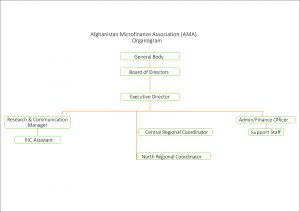History:
The Afghanistan Microfinance Association (AMA) is the national network of development finance Institutions in Afghanistan. AMA aims to promote, support, strengthen, and provide appropriate support to institutions involved in the developmental finance sector in Afghanistan through effective lobbying and advocacy on behalf of the sector, knowledge management, sector coordination & networking, and capacity building. AMA registered with the Ministry of Justice in 2007 and is considered a reliable source of information and a coordinator of the microfinance sector in Afghanistan. AMA is one of the founding members of the South Asian Micro-entrepreneur Network (SAMN) and has been an active member since 2009. Currently, AMA serves as a Board member of the Board of Directors of SAMN.
Vision:
To promote financial inclusion through creation of an enabling environment for the development finance sector in Afghanistan.
Mission:
To build an inclusive, sustainable and responsible development finance sector through policy advocacy, knowledge management, coordination and networking, and capacity building.
Governance:
As an independent legal entity, AMA is governed by a Board of Directors. The General Assembly, constituted with the participation of a representative from each member, is the highest decision-making body. The Board of Directors is composed of five members drawn from a diverse field of experiences such as development finance, management, and economics, among others. The General Assembly meets at least once a year, while the Board meets once every quarter, reviews the quarterly progress, advises the management on day-to-day operations, and takes collective decisions accordingly. There are also a number of need-based Working Groups and Sub-Committees formed for specific purposes, for example, Finance and Audit, Advocacy, and Fund Raising Committees.
Management:
AMA has adopted a decentralized organizational structure with separate Board and Management team responsibilities. Day-to-day management of AMA is carried out by the senior management team headed by the Executive Director (ED).
The ED leads the organization with support from three Managers: Member Services, Research and Communication, Finance and Admin at Head Office, and four Regional Coordinators.



